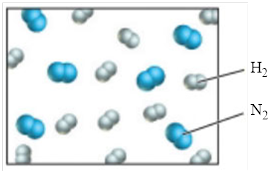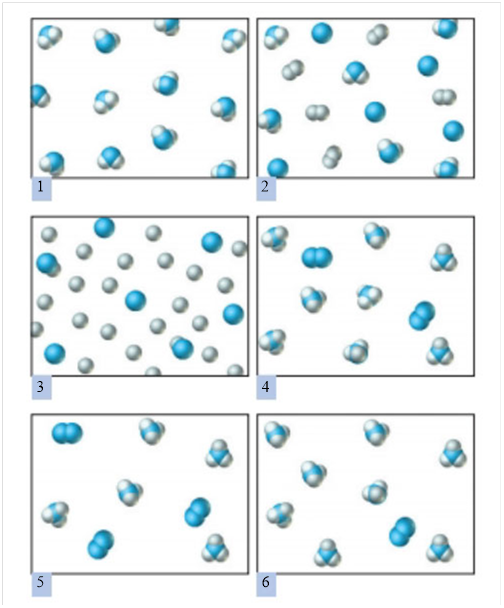
Introductory Chemistry: An Active Learning Approach
6th Edition
ISBN: 9781305079250
Author: Mark S. Cracolice, Ed Peters
Publisher: Cengage Learning
expand_more
expand_more
format_list_bulleted
Concept explainers
Textbook Question
Chapter 10, Problem 41E
Ammonia can be formed from a combination reaction of its elements. A small fraction of an unreacted mixture of elements is illustrated in the following diagram, in which white spheres represent hydrogen atoms and blue spheres represent nitrogen atoms. The temperature is such that all species are gases.

a) Write and balance the equation for the reaction.
b) Which of the following correctly represents the product mixture?

c) Which species is the limiting reactant? Explain.
Expert Solution & Answer
Want to see the full answer?
Check out a sample textbook solution
Students have asked these similar questions
help
helpME
Draw the major product of
this reaction. Ignore inorganic
byproducts.
Assume that the water side
product is continuously
removed to drive the reaction
toward products.
(CH3)2NH,
TSOH
Drawing
Chapter 10 Solutions
Introductory Chemistry: An Active Learning Approach
Ch. 10 - The first step in the Ostwald process for...Ch. 10 - When hydrogen sulfide reacts with oxygen, water...Ch. 10 - Magnesium hydroxide is formed from the reaction of...Ch. 10 - In our bodies, sugar is broken down by reacting...Ch. 10 - Prob. 5ECh. 10 - Aqueous solutions of potassium hydrogen sulfate...Ch. 10 - The first step in the Ostwald process for...Ch. 10 - Butane, C4H10 is a common fuel used for heating...Ch. 10 - The explosion of nitroglycerine is described by...Ch. 10 - According to the reaction 2AgNO3+CuCu(NO3)2+2Ag,...
Ch. 10 - Prob. 11ECh. 10 - Prob. 12ECh. 10 - Prob. 13ECh. 10 - Prob. 14ECh. 10 - The hard water scum that forms a ring around the...Ch. 10 - Prob. 16ECh. 10 - Prob. 17ECh. 10 - Prob. 18ECh. 10 - The Solvay process is multistep industrial method...Ch. 10 - Prob. 20ECh. 10 - Prob. 21ECh. 10 - What mass of NaHCO3 must decompose to produce 448g...Ch. 10 - Prob. 23ECh. 10 - Solid ammonium chloride decomposes to form ammonia...Ch. 10 - What mass of magnesium hydroxide will precipitate...Ch. 10 - Prob. 26ECh. 10 - Prob. 27ECh. 10 - Prob. 28ECh. 10 - The reaction of a dry cell battery may be...Ch. 10 - Prob. 30ECh. 10 - Prob. 31ECh. 10 - Prob. 32ECh. 10 - Calcium cyanamide is a common fertilizer. When...Ch. 10 - Prob. 34ECh. 10 - The Haber process for making ammonia from nitrogen...Ch. 10 - Prob. 36ECh. 10 - Prob. 37ECh. 10 - The simplest example of the hydrogenation of a...Ch. 10 - Prob. 39ECh. 10 - Prob. 40ECh. 10 - Ammonia can be formed from a combination reaction...Ch. 10 - Carbon monoxide reacts with oxygen to form carbon...Ch. 10 - An experiment is conducted in which varying...Ch. 10 - The flasks below illustrated three trials of a...Ch. 10 - A solution containing 1.63g of barium chloride is...Ch. 10 - Prob. 46ECh. 10 - Prob. 47ECh. 10 - Prob. 48ECh. 10 - A mixture of tetraphosphorus trisulfide and...Ch. 10 - Sodium carbonate can neutralize nitric acid by the...Ch. 10 - Prob. 51ECh. 10 - Prob. 52ECh. 10 - Prob. 53ECh. 10 - Prob. 54ECh. 10 - Prob. 55ECh. 10 - Prob. 56ECh. 10 - Prob. 57ECh. 10 - Prob. 58ECh. 10 - Prob. 59ECh. 10 - Prob. 60ECh. 10 - Question 57 through 62: Thermochemical equations...Ch. 10 - Prob. 62ECh. 10 - Quicklime, the common name for calcium oxide, CaO,...Ch. 10 - What mass in grams of hydrogen has to react to...Ch. 10 - The quicklime produced in Question 63 is...Ch. 10 - Prob. 66ECh. 10 - What mass in grams of octane, a component of...Ch. 10 - Calculate the quantity of energy (kJ) transferred...Ch. 10 - Prob. 69ECh. 10 - Classify each of the following statements as true...Ch. 10 - Prob. 71ECh. 10 - What mass in grams of calcium phosphate will...Ch. 10 - Prob. 73ECh. 10 - Prob. 74ECh. 10 - A laboratory test of 12.8g of aluminum ore yields...Ch. 10 - How much energy is required to decompose 1.42g of...Ch. 10 - Prob. 77ECh. 10 - Prob. 78ECh. 10 - A sludge containing silver chloride is a water...Ch. 10 - Prob. 80ECh. 10 - Prob. 81ECh. 10 - Prob. 82ECh. 10 - Prob. 83ECh. 10 - Prob. 84ECh. 10 - In 1866, a young chemistry student conceived the...Ch. 10 - Prob. 86ECh. 10 - A student was given a 1.6240-g sample of a mixture...Ch. 10 - A researcher dissolved 1.382g of impure copper in...Ch. 10 - What mass in grams of magnesium nitrate, Mg(NO3)2,...Ch. 10 - Prob. 90ECh. 10 - Prob. 10.1TCCh. 10 - Solutions of zinc bromide and sodium hydroxide are...Ch. 10 - Prob. 2PECh. 10 - Prob. 3PECh. 10 - How mass of fluorine is formed when 3.0grams of...Ch. 10 - Prob. 5PECh. 10 - Prob. 6PECh. 10 - Prob. 7PECh. 10 - Prob. 8PECh. 10 - Prob. 9PECh. 10 - A solution containing 43.5g of calcium nitrate is...Ch. 10 - Prob. 11PECh. 10 - Prob. 12PECh. 10 - Prob. 13PECh. 10 - Prob. 14PECh. 10 - Prob. 15PECh. 10 - Prob. 1PCECh. 10 - Prob. 2PCECh. 10 - Prob. 3PCECh. 10 - Prob. 4PCECh. 10 - Prob. 5PCECh. 10 - Prob. 6PCECh. 10 - Eight problem-classification examples follow. Test...Ch. 10 - Prob. 8PCE
Knowledge Booster
Learn more about
Need a deep-dive on the concept behind this application? Look no further. Learn more about this topic, chemistry and related others by exploring similar questions and additional content below.Similar questions
- So, the first image is what I'm trying to understand regarding my approach. The second image illustrates my teacher's method, and the third image includes my notes on the concepts behind these types of problems.arrow_forwardHAND DRAWarrow_forwardDraw a mental model for calcium chloride mixed with sodium phosphatearrow_forward
- here is my question (problem number 20) please explain to me thanks!arrow_forwardThe bromination of anisole is an extremely fast reaction. Complete the resonance structures of the intermediate arenium cation for the reaction (Part 1), and then answer the question that follows (Part 2).arrow_forwardDrawing of 3-fluro-2methylphenolarrow_forward
- Which compound(s) will be fully deprotonated (>99%) by reaction with one molar equivalent of sodium hydroxide? I, II, III I, || I, III I only II, III SH | H3C-C=C-H || III NH2arrow_forwardWill NBS (and heat or light) work for this reaction, or do we have to use Br2?arrow_forwardHAND DRAWarrow_forward
- Predict the major products of the following organic reaction: Some important notes: Δ CN ? • Draw the major product, or products, of the reaction in the drawing area below. • If there aren't any products, because no reaction will take place, check the box below the drawing area instead. Be sure to use wedge and dash bonds when necessary, for example to distinguish between major products that are enantiomers. ONO reaction. Click and drag to start drawing a structure.arrow_forwardThe following product was made from diethyl ketone and what other reagent(s)? £ HO 10 2-pentyne 1-butyne and NaNH2 ☐ 1-propanol ☐ pyridine butanal ☐ pentanoatearrow_forwardWhich pair of reagents will form the given product? OH X + Y a. CH3 b. CH2CH3 ༧་་ C. CH3- CH2CH3 d.o6.(རི॰ e. CH3 OCH2CH3 -MgBr f. CH3-MgBr g. CH3CH2-MgBr -C-CH3 CH2CH3arrow_forward
arrow_back_ios
SEE MORE QUESTIONS
arrow_forward_ios
Recommended textbooks for you
 Introductory Chemistry: An Active Learning Approa...ChemistryISBN:9781305079250Author:Mark S. Cracolice, Ed PetersPublisher:Cengage Learning
Introductory Chemistry: An Active Learning Approa...ChemistryISBN:9781305079250Author:Mark S. Cracolice, Ed PetersPublisher:Cengage Learning World of Chemistry, 3rd editionChemistryISBN:9781133109655Author:Steven S. Zumdahl, Susan L. Zumdahl, Donald J. DeCostePublisher:Brooks / Cole / Cengage Learning
World of Chemistry, 3rd editionChemistryISBN:9781133109655Author:Steven S. Zumdahl, Susan L. Zumdahl, Donald J. DeCostePublisher:Brooks / Cole / Cengage Learning Chemistry for Today: General, Organic, and Bioche...ChemistryISBN:9781305960060Author:Spencer L. Seager, Michael R. Slabaugh, Maren S. HansenPublisher:Cengage Learning
Chemistry for Today: General, Organic, and Bioche...ChemistryISBN:9781305960060Author:Spencer L. Seager, Michael R. Slabaugh, Maren S. HansenPublisher:Cengage Learning- Chemistry: Matter and ChangeChemistryISBN:9780078746376Author:Dinah Zike, Laurel Dingrando, Nicholas Hainen, Cheryl WistromPublisher:Glencoe/McGraw-Hill School Pub Co
 Introductory Chemistry: A FoundationChemistryISBN:9781337399425Author:Steven S. Zumdahl, Donald J. DeCostePublisher:Cengage Learning
Introductory Chemistry: A FoundationChemistryISBN:9781337399425Author:Steven S. Zumdahl, Donald J. DeCostePublisher:Cengage Learning Introductory Chemistry: A FoundationChemistryISBN:9781285199030Author:Steven S. Zumdahl, Donald J. DeCostePublisher:Cengage Learning
Introductory Chemistry: A FoundationChemistryISBN:9781285199030Author:Steven S. Zumdahl, Donald J. DeCostePublisher:Cengage Learning

Introductory Chemistry: An Active Learning Approa...
Chemistry
ISBN:9781305079250
Author:Mark S. Cracolice, Ed Peters
Publisher:Cengage Learning

World of Chemistry, 3rd edition
Chemistry
ISBN:9781133109655
Author:Steven S. Zumdahl, Susan L. Zumdahl, Donald J. DeCoste
Publisher:Brooks / Cole / Cengage Learning

Chemistry for Today: General, Organic, and Bioche...
Chemistry
ISBN:9781305960060
Author:Spencer L. Seager, Michael R. Slabaugh, Maren S. Hansen
Publisher:Cengage Learning

Chemistry: Matter and Change
Chemistry
ISBN:9780078746376
Author:Dinah Zike, Laurel Dingrando, Nicholas Hainen, Cheryl Wistrom
Publisher:Glencoe/McGraw-Hill School Pub Co

Introductory Chemistry: A Foundation
Chemistry
ISBN:9781337399425
Author:Steven S. Zumdahl, Donald J. DeCoste
Publisher:Cengage Learning

Introductory Chemistry: A Foundation
Chemistry
ISBN:9781285199030
Author:Steven S. Zumdahl, Donald J. DeCoste
Publisher:Cengage Learning
Bonding (Ionic, Covalent & Metallic) - GCSE Chemistry; Author: Science Shorts;https://www.youtube.com/watch?v=p9MA6Od-zBA;License: Standard YouTube License, CC-BY
Stoichiometry - Chemistry for Massive Creatures: Crash Course Chemistry #6; Author: Crash Course;https://www.youtube.com/watch?v=UL1jmJaUkaQ;License: Standard YouTube License, CC-BY